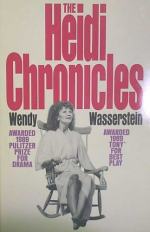|
This section contains 338 words (approx. 1 page at 400 words per page) |

|
The Heidi Chronicles Summary & Study Guide Description
The Heidi Chronicles Summary & Study Guide includes comprehensive information and analysis to help you understand the book. This study guide contains the following sections:
This detailed literature summary also contains Bibliography and a Free Quiz on The Heidi Chronicles by Wendy Wasserstein.
Wendy Wasserstein's The Heidi Chronicles is her best-known play. It was first produced Off-Broadway at Playwrights Horizons, December 11, 1988, running for three sold-out months, before moving to the Plymouth Theater on Broadway on March 9, 1989. The play averaged 90% full houses during its run and, in 1989, garnered numerous awards, including the Pulitzer Prize for drama as well as the Antoinette Perry (Tony) and New York Drama Critics' Circle awards for best play. Other honors include the Outer Critics Circle Award, the Dramatists Guild's Hull-Warriner Award, and the Susan Smith Blackburn Award for women playwrights.
Following its debut, critical reaction to The Heidi Chronicles was mixed. Many praised Wasserstein for her unflinching portrayal of the Baby Boom generation's coming of age. Heidi is a character typical of many women born in the post-World War II era: she is intelligent, well-educated, and attempting to make it in a society dominated by men. While many critics admired the events Wasserstein depicts, some faulted her for undermining the play's serious issues with sitcom humor, half-baked characters like the indecisive Susan Johnston, and a contrived ending.
Many feminists also found fault with The Heidi Chronicles. While some were happy that a play with strong feminist themes was a mainstream success, they were displeased with Wasserstein's negative comments (primarily through the voices of her male characters) on the woman's movement. The title character Heidi is often a mute observer, dominated by her two male friends, Scoop and Peter. Feminists believed that Wasserstein blames the women's movement for the fact that women are trivial and men more serious.
Despite such complaints, The Heidi Chronicles is largely seen as a success in the subgenre of feminist theatre. The play distinguished Wasserstein as a significant dramatic voice of the Baby Boom generation. Political/gender issues aside, most critics and viewers found the play to be entertaining and few could deny Wasserstein's facility with comedic dialogue. Moreover, many women did relate to Heidi's search for her own identity and the anguish she suffers as a woman in modern society.
Read more from the Study Guide
|
This section contains 338 words (approx. 1 page at 400 words per page) |

|



